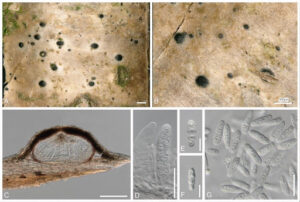Arthopyrenia cerasi (Schrad.) A. Massal., Ric. auton. lich. crost. (Verona): 167 (1852)
Index Fungorum number: 377023
Description (adapted from Coppins & Orange 2009): Thallus inconspicuous or slightly bleaching the bark, endophloeodal, photobiont absent. Sexual morph: Ascomata perithecial, c. 300–500 μm diam., black, rounded to often ellipsoid, somewhat adnate, ostiolate. Ostiole distinct, centrally located. Involucrellum dark brown, K+ greenish. Exciple light brown. Pseudoparaphyses slender, anastomosing, 1.5–2 µm. Asci 80–85 μm, 8-spored, bitunicate, cylindrical-clavate, Ascospores 17–22 × 5–7 μm, irregularly biseriate, hyaline, clavate to obovoid, rounded at the apex when mature, constricted at each septum, 3-septate, gelatinous c. 2 µm thick in K. Asexual morph: Pycnidia 80–120 µm, with either macro- or microconidia. Macroconidia 11–13 × 2–3 μm, oblong, hyaline, 3-septate. Microconidia 9–14 × 0.8 µm.
Material examined – Europe
Notes – Arthopyrenia cerasi is the type of the genus Arthopyrenia. This species is characterized by a non-lichenized thallus, perithecial ascomata with a brown, K+, greenish involucrellum, anastomosing pseudoparaphyses, cylindrical asci with hyaline 3-septate ascospores and conidiomata producing frequently 3-septate macroconidia (Coppins 1988). This species often grows on Corylus and is distributed in the North and West British Isles (Coppins & Orange 2009).

Figure. 1 Arthopyrenia cerasi (Coppins 25807) A, B Ascomata and conidiomata on bark. C Cross section of ascoma in water. D Asci in water. E, F Ascospores in water G Macroconidia in water. Scale bars: B = 500 μm, C = 100 μm, D = 30 μm, E–G = 10 μm
